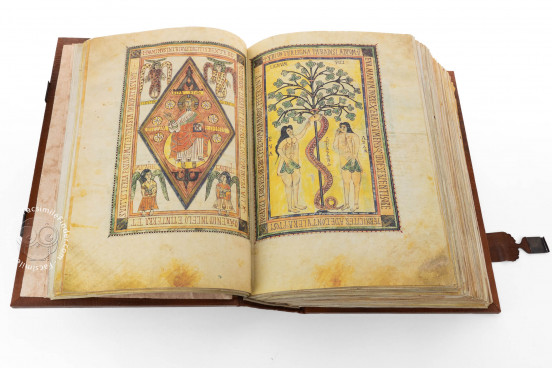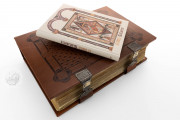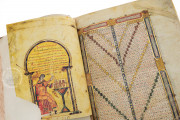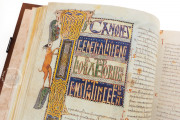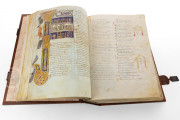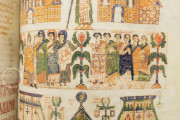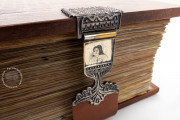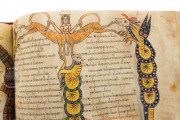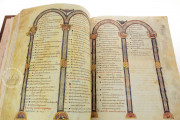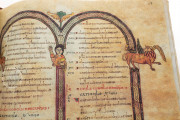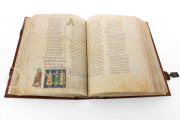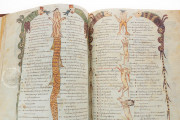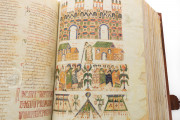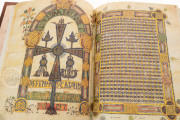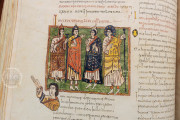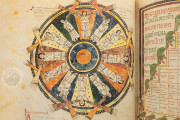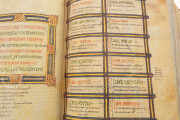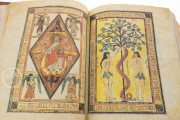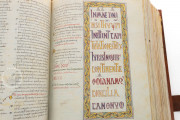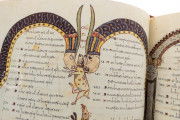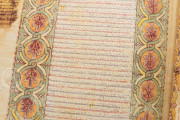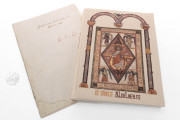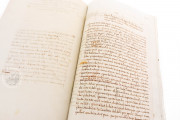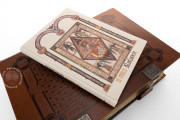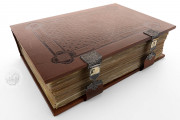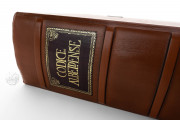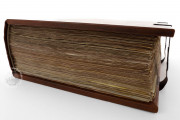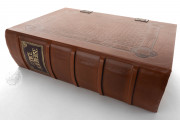The Albelda Codex is a magisterial compilation of texts of great variety, opening with a collection of excerpts from the Etymologies of Isidore of Seville and concluding with the Visigothic civil law code known as the Liber judicum. The manuscript was created at the Benedictine monastery of San Martín at Albelda and completed in 976 for the monastery's abbot, Maurelio. The manuscript boasts eighty-two miniatures, as well as colored diagrams, painted incipit pages, and decorated initials.
Among the Albelda manuscript's myriad texts are records of councils of the early Christian Church, a calendar, a biography of Muhammad, homilies by Gregory the Great, sermons by Saint Augustine, chapters of the Rule of Saint Benedict, and a chronicle of the monastery at Albelda.
No Expense Spared
The Albelda Codex is a lavish production, its texts embellished by figural paintings, elaborately painted architecture, and colored diagrams in a palette dominated by bright colors and gold and silver. Painted initials with interlace designs introduce some of the texts.
An unusual feature of a circular diagram of the twelve winds—each pictured as a man blowing a horn or horns—is the inclusion of the names of all twelve winds (fol. 14v). A pair of full-page miniatures (fols. 16v-17r) in elaborate frames containing inscriptions introduces Isidore of Seville's discussion of paradise. The paintings show Christ in Majesty surrounded by angels facing the Fall of Humanity, featuring an outsized snake-like serpent.
Painted Architecture
Thirty pages listing the contents of various church councils have framing elements of columns topped by arches of great variety (fols. 56v-70r). Indeed, the architecture is sometimes transformed into animals, fish, and hybrid beasts (fols. 57v and 58v-60v), or human busts, animals, and birds take the place of column capitals (fols. 66v-68v and 69v).
Law Givers and Manuscript Makers
A full-page miniature divided into nine compartments follows the text of the Visigothic law code (fol. 428r). It depicts the three kings who were understood to be responsible for the laws, three rulers of Pamplona at the time the manuscript was made, and the scribes Sarracino, Vigilas, and Garsea.
The Visigothic kings are portrayed wearing distinctive crowns of triangular shape with projecting bands that resemble horns. Each holds a scroll or book representing the law code. The contemporary royal figures in the middle register are depicted dressed in either a purple tunic or a purple robe. The scribes are all pictured holding scrolls, even though their work is contained in a codex, probably a reference to the authority of the text they copied.
Vigilas, Master Scribe
Vigilas was responsible for writing most of the manuscript's Latin text in two columns in Visigothic Minuscule, the distinctive script of the Iberian Peninsula. He was assisted by Sarracino, identified as Vigilas's associate, and Garsea, described as his pupil. It has been suggested that Vigilas also contributed to the book's illumination.
Titles are often written in large display script in colored inks employing both Visigothic and Uncial letterforms. The manuscript includes an early example of the writing of Arabic numerals in Europe (fol. 12v).
A Part of the Founding Collection of the El Escorial
Juan de Acuña y Acuña (d. 1592), Count of Buendía, gave the Albelda Codex to Philip II (1527-1598), King of Spain, and it has been a treasure of Philip's royal library at the monastery of San Lorenzo at El Escorial since 1592, when the library's construction was completed. It is preserved in an Escorial binding of brown leather over pasteboard.
We have 1 facsimile edition of the manuscript "Albelda Codex": Códice Albeldense facsimile edition, published by Testimonio Compañía Editorial, 2000
Request Info / Price

